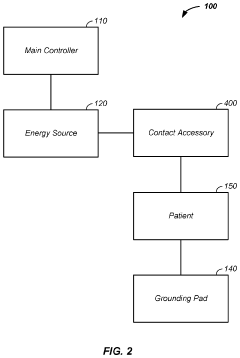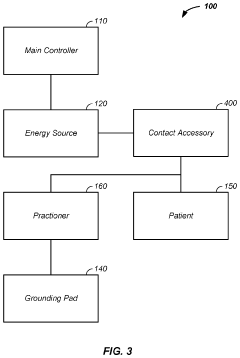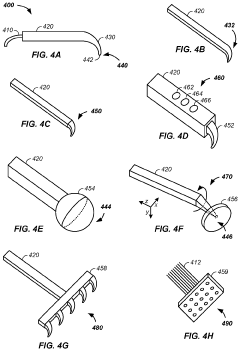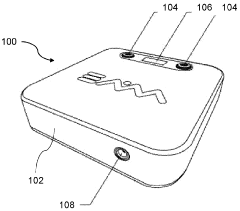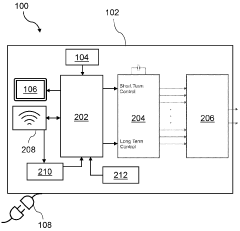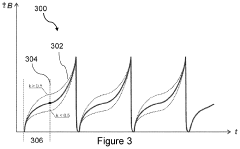Innovations in PEMF Therapy Delivery Systems and Protocols
AUG 11, 20259 MIN READ
Generate Your Research Report Instantly with AI Agent
Patsnap Eureka helps you evaluate technical feasibility & market potential.
PEMF Therapy Evolution
Pulsed Electromagnetic Field (PEMF) therapy has undergone significant evolution since its inception in the mid-20th century. Initially developed for bone healing, PEMF therapy has expanded its applications to various medical conditions, showcasing its versatility and potential in healthcare.
The early stages of PEMF therapy focused primarily on bone-related issues. In the 1950s, researchers discovered that electrical currents could stimulate bone growth, leading to the development of the first PEMF devices. These early systems were bulky and limited in their applications, primarily used in clinical settings for treating non-union fractures.
The 1970s and 1980s saw a surge in PEMF research, expanding its potential beyond bone healing. Scientists began exploring its effects on soft tissue repair, pain management, and cellular function. This period marked the transition of PEMF therapy from a niche treatment to a more widely recognized therapeutic modality.
A significant milestone in PEMF evolution came in 1979 when the FDA approved its use for treating non-union fractures. This approval paved the way for broader acceptance and integration of PEMF therapy into mainstream medical practices. Subsequently, research expanded into areas such as wound healing, inflammation reduction, and neurological disorders.
The 1990s and early 2000s brought about miniaturization and improved portability of PEMF devices. This technological advancement allowed for home-based treatments, making PEMF therapy more accessible to patients. The development of wearable PEMF devices further enhanced convenience and treatment compliance.
Recent years have seen a focus on optimizing PEMF protocols and delivery systems. Researchers have been fine-tuning frequency ranges, pulse shapes, and field intensities to target specific conditions more effectively. The integration of PEMF with other therapies, such as regenerative medicine and physical therapy, has opened new avenues for comprehensive treatment approaches.
Advancements in digital technology have led to the development of smart PEMF devices. These systems can adjust treatment parameters based on real-time biofeedback, potentially improving therapeutic outcomes. Additionally, the incorporation of artificial intelligence and machine learning algorithms is enhancing the personalization of PEMF treatments.
The evolution of PEMF therapy has also seen an expansion in its application scope. While initially focused on musculoskeletal issues, current research explores its potential in treating neurological disorders, cardiovascular conditions, and even certain types of cancer. This broadening of applications reflects the growing understanding of PEMF's effects on cellular and systemic levels.
As PEMF therapy continues to evolve, ongoing research aims to establish standardized protocols for various conditions, improve device efficiency, and explore novel delivery methods. The future of PEMF therapy looks promising, with potential developments in nanotechnology-based delivery systems and integration with emerging medical technologies.
The early stages of PEMF therapy focused primarily on bone-related issues. In the 1950s, researchers discovered that electrical currents could stimulate bone growth, leading to the development of the first PEMF devices. These early systems were bulky and limited in their applications, primarily used in clinical settings for treating non-union fractures.
The 1970s and 1980s saw a surge in PEMF research, expanding its potential beyond bone healing. Scientists began exploring its effects on soft tissue repair, pain management, and cellular function. This period marked the transition of PEMF therapy from a niche treatment to a more widely recognized therapeutic modality.
A significant milestone in PEMF evolution came in 1979 when the FDA approved its use for treating non-union fractures. This approval paved the way for broader acceptance and integration of PEMF therapy into mainstream medical practices. Subsequently, research expanded into areas such as wound healing, inflammation reduction, and neurological disorders.
The 1990s and early 2000s brought about miniaturization and improved portability of PEMF devices. This technological advancement allowed for home-based treatments, making PEMF therapy more accessible to patients. The development of wearable PEMF devices further enhanced convenience and treatment compliance.
Recent years have seen a focus on optimizing PEMF protocols and delivery systems. Researchers have been fine-tuning frequency ranges, pulse shapes, and field intensities to target specific conditions more effectively. The integration of PEMF with other therapies, such as regenerative medicine and physical therapy, has opened new avenues for comprehensive treatment approaches.
Advancements in digital technology have led to the development of smart PEMF devices. These systems can adjust treatment parameters based on real-time biofeedback, potentially improving therapeutic outcomes. Additionally, the incorporation of artificial intelligence and machine learning algorithms is enhancing the personalization of PEMF treatments.
The evolution of PEMF therapy has also seen an expansion in its application scope. While initially focused on musculoskeletal issues, current research explores its potential in treating neurological disorders, cardiovascular conditions, and even certain types of cancer. This broadening of applications reflects the growing understanding of PEMF's effects on cellular and systemic levels.
As PEMF therapy continues to evolve, ongoing research aims to establish standardized protocols for various conditions, improve device efficiency, and explore novel delivery methods. The future of PEMF therapy looks promising, with potential developments in nanotechnology-based delivery systems and integration with emerging medical technologies.
Market Demand Analysis
The market demand for PEMF (Pulsed Electromagnetic Field) therapy delivery systems and protocols has been steadily increasing in recent years, driven by growing awareness of its potential health benefits and the rising prevalence of chronic conditions. The global PEMF therapy devices market is expected to experience significant growth, with projections indicating a compound annual growth rate (CAGR) of over 7% from 2021 to 2026.
One of the primary factors fueling this market expansion is the increasing adoption of PEMF therapy for pain management and rehabilitation. As the global population ages and the incidence of musculoskeletal disorders rises, there is a growing demand for non-invasive and drug-free treatment options. PEMF therapy has shown promising results in alleviating pain associated with conditions such as osteoarthritis, fibromyalgia, and chronic back pain, making it an attractive alternative to traditional pain management approaches.
The sports medicine sector has also emerged as a significant driver of market demand for PEMF therapy systems. Professional athletes and sports teams are increasingly incorporating PEMF therapy into their training and recovery regimens to enhance performance, reduce injury recovery times, and manage chronic pain. This trend is expected to trickle down to amateur athletes and fitness enthusiasts, further expanding the market potential.
In the healthcare sector, there is a growing interest in integrating PEMF therapy into post-surgical care and wound healing protocols. Clinical studies have demonstrated the efficacy of PEMF in accelerating tissue repair and reducing inflammation, leading to faster recovery times and improved patient outcomes. This has sparked interest among healthcare providers and institutions in adopting PEMF therapy as a complementary treatment modality.
The home healthcare segment represents another area of significant market potential for PEMF therapy devices. As consumers become more health-conscious and seek out self-care solutions, portable and user-friendly PEMF devices for home use are gaining popularity. This trend has been further accelerated by the COVID-19 pandemic, which has increased the demand for at-home wellness and therapy options.
Geographically, North America currently dominates the PEMF therapy devices market, followed by Europe. However, the Asia-Pacific region is expected to witness the highest growth rate in the coming years, driven by increasing healthcare expenditure, rising awareness of alternative therapies, and a large patient population with chronic conditions.
Despite the positive market outlook, challenges remain in terms of regulatory approvals and reimbursement policies for PEMF therapy. As innovations in delivery systems and protocols continue to emerge, addressing these barriers will be crucial for realizing the full market potential of PEMF therapy technologies.
One of the primary factors fueling this market expansion is the increasing adoption of PEMF therapy for pain management and rehabilitation. As the global population ages and the incidence of musculoskeletal disorders rises, there is a growing demand for non-invasive and drug-free treatment options. PEMF therapy has shown promising results in alleviating pain associated with conditions such as osteoarthritis, fibromyalgia, and chronic back pain, making it an attractive alternative to traditional pain management approaches.
The sports medicine sector has also emerged as a significant driver of market demand for PEMF therapy systems. Professional athletes and sports teams are increasingly incorporating PEMF therapy into their training and recovery regimens to enhance performance, reduce injury recovery times, and manage chronic pain. This trend is expected to trickle down to amateur athletes and fitness enthusiasts, further expanding the market potential.
In the healthcare sector, there is a growing interest in integrating PEMF therapy into post-surgical care and wound healing protocols. Clinical studies have demonstrated the efficacy of PEMF in accelerating tissue repair and reducing inflammation, leading to faster recovery times and improved patient outcomes. This has sparked interest among healthcare providers and institutions in adopting PEMF therapy as a complementary treatment modality.
The home healthcare segment represents another area of significant market potential for PEMF therapy devices. As consumers become more health-conscious and seek out self-care solutions, portable and user-friendly PEMF devices for home use are gaining popularity. This trend has been further accelerated by the COVID-19 pandemic, which has increased the demand for at-home wellness and therapy options.
Geographically, North America currently dominates the PEMF therapy devices market, followed by Europe. However, the Asia-Pacific region is expected to witness the highest growth rate in the coming years, driven by increasing healthcare expenditure, rising awareness of alternative therapies, and a large patient population with chronic conditions.
Despite the positive market outlook, challenges remain in terms of regulatory approvals and reimbursement policies for PEMF therapy. As innovations in delivery systems and protocols continue to emerge, addressing these barriers will be crucial for realizing the full market potential of PEMF therapy technologies.
Technical Challenges
PEMF (Pulsed Electromagnetic Field) therapy, while promising, faces several technical challenges that hinder its widespread adoption and efficacy. One of the primary obstacles is the development of precise and controllable electromagnetic field generation systems. Current devices often struggle to produce consistent and reproducible field patterns, leading to variability in treatment outcomes. This inconsistency makes it difficult to establish standardized protocols and dosages for different medical conditions.
Another significant challenge lies in the miniaturization and portability of PEMF devices. Many existing systems are bulky and require a constant power source, limiting their use in home or ambulatory settings. The development of compact, energy-efficient, and long-lasting battery-powered devices remains a key area of focus for researchers and engineers in the field.
The optimization of treatment parameters presents another hurdle. PEMF therapy involves complex interactions between electromagnetic fields and biological tissues, and determining the ideal frequency, intensity, and duration of treatment for various conditions is an ongoing challenge. This complexity is compounded by individual variations in patient physiology and the specific nature of different medical conditions, necessitating personalized treatment approaches.
Ensuring the safety and biocompatibility of PEMF devices is also a critical concern. While PEMF therapy is generally considered safe, long-term effects of repeated exposure to electromagnetic fields are not fully understood. Developing systems that minimize potential risks while maximizing therapeutic benefits requires extensive research and rigorous testing.
The integration of PEMF technology with other treatment modalities and diagnostic tools poses additional technical challenges. Creating systems that can work synergistically with other therapies or provide real-time feedback on treatment efficacy requires sophisticated engineering and interdisciplinary collaboration.
Lastly, the development of advanced control systems and user interfaces for PEMF devices remains an area of active research. Creating intuitive, user-friendly interfaces that allow for precise control of treatment parameters while ensuring patient compliance and safety is crucial for the widespread adoption of this technology in clinical and home settings.
Another significant challenge lies in the miniaturization and portability of PEMF devices. Many existing systems are bulky and require a constant power source, limiting their use in home or ambulatory settings. The development of compact, energy-efficient, and long-lasting battery-powered devices remains a key area of focus for researchers and engineers in the field.
The optimization of treatment parameters presents another hurdle. PEMF therapy involves complex interactions between electromagnetic fields and biological tissues, and determining the ideal frequency, intensity, and duration of treatment for various conditions is an ongoing challenge. This complexity is compounded by individual variations in patient physiology and the specific nature of different medical conditions, necessitating personalized treatment approaches.
Ensuring the safety and biocompatibility of PEMF devices is also a critical concern. While PEMF therapy is generally considered safe, long-term effects of repeated exposure to electromagnetic fields are not fully understood. Developing systems that minimize potential risks while maximizing therapeutic benefits requires extensive research and rigorous testing.
The integration of PEMF technology with other treatment modalities and diagnostic tools poses additional technical challenges. Creating systems that can work synergistically with other therapies or provide real-time feedback on treatment efficacy requires sophisticated engineering and interdisciplinary collaboration.
Lastly, the development of advanced control systems and user interfaces for PEMF devices remains an area of active research. Creating intuitive, user-friendly interfaces that allow for precise control of treatment parameters while ensuring patient compliance and safety is crucial for the widespread adoption of this technology in clinical and home settings.
Current PEMF Solutions
01 PEMF therapy devices and applicators
Various devices and applicators are used for delivering Pulsed Electromagnetic Field (PEMF) therapy. These include coils, mats, and specialized applicators designed to target specific areas of the body. The devices generate pulsed electromagnetic fields of varying frequencies and intensities to stimulate cellular repair and promote healing.- PEMF therapy devices and applicators: Various devices and applicators are used for delivering Pulsed Electromagnetic Field (PEMF) therapy. These include coils, mats, and specialized applicators designed to target specific areas of the body. The devices generate pulsed electromagnetic fields of varying frequencies and intensities to stimulate cellular repair and promote healing.
- PEMF therapy protocols and treatment regimens: PEMF therapy protocols involve specific treatment regimens, including the duration, frequency, and intensity of electromagnetic field exposure. These protocols are tailored to different medical conditions and may involve multiple sessions over a period of time. The treatment plans are designed to optimize therapeutic effects while ensuring patient safety.
- Integration of PEMF therapy with other technologies: PEMF therapy is often integrated with other technologies to enhance its effectiveness. This includes combining PEMF with biofeedback systems, mobile applications for treatment monitoring, and telemedicine platforms for remote therapy management. Such integrations aim to improve treatment outcomes and patient compliance.
- Customization and control of PEMF therapy: Advanced PEMF systems offer customization and precise control of therapy parameters. This includes adjustable field strengths, programmable pulse patterns, and user-specific settings. Such customization allows for personalized treatment approaches tailored to individual patient needs and specific medical conditions.
- PEMF therapy delivery systems for specific applications: Specialized PEMF delivery systems are developed for specific medical applications. These include systems designed for pain management, wound healing, bone growth stimulation, and neurological disorders. The delivery systems are optimized for the target application, considering factors such as penetration depth and field distribution.
02 PEMF therapy protocols and treatment regimens
PEMF therapy protocols involve specific treatment regimens, including the frequency, intensity, and duration of electromagnetic field exposure. These protocols are tailored to different medical conditions and may involve multiple sessions over a period of time. The treatment plans are designed to optimize therapeutic effects while ensuring patient safety.Expand Specific Solutions03 Integration of PEMF therapy with other technologies
PEMF therapy is often integrated with other technologies to enhance its effectiveness. This includes combining PEMF with biofeedback systems, wearable devices, and mobile applications. Such integration allows for personalized treatment, real-time monitoring, and data analysis to improve therapy outcomes.Expand Specific Solutions04 Wireless and remote PEMF therapy systems
Advancements in wireless technology have led to the development of remote PEMF therapy systems. These systems allow for the delivery of PEMF therapy without direct physical connection to the device, enabling greater flexibility in treatment locations and improving patient comfort. They often incorporate mobile connectivity for remote monitoring and control.Expand Specific Solutions05 PEMF therapy control and management systems
Sophisticated control and management systems are employed in PEMF therapy to regulate and optimize treatment parameters. These systems may include software for treatment planning, dose calculation, and therapy customization. They often feature user interfaces for healthcare providers to adjust settings and monitor patient progress.Expand Specific Solutions
Key Industry Players
The field of PEMF (Pulsed Electromagnetic Field) Therapy Delivery Systems and Protocols is in a growth phase, with increasing market size and technological advancements. The global PEMF therapy market is expanding rapidly, driven by growing awareness of non-invasive pain management techniques and the rising prevalence of chronic diseases. Companies like Regenesis Biomedical, Galvanize Therapeutics, and Venus Concept are at the forefront, developing innovative PEMF devices and protocols. The technology's maturity varies, with established players like Baxter International and Medtronic offering more refined solutions, while newer entrants like Biomagnetic Sciences and SofPulse are introducing novel approaches. The competitive landscape is diverse, encompassing medical device manufacturers, specialized PEMF therapy companies, and research institutions, indicating a dynamic and evolving market with significant potential for further innovation and growth.
Regenesis Biomedical, Inc.
Technical Solution: Regenesis Biomedical has developed innovative PEMF therapy delivery systems, focusing on targeted tissue regeneration. Their Provant Therapy System utilizes a proprietary pulsed radiofrequency energy technology to stimulate cellular repair and reduce inflammation[1]. The system delivers non-thermal radiofrequency energy to the treatment area, promoting angiogenesis and tissue healing. Regenesis has also implemented advanced treatment protocols that optimize the frequency, intensity, and duration of PEMF therapy based on specific tissue types and conditions[2]. Their approach combines precise energy delivery with customized treatment plans to enhance therapeutic outcomes.
Strengths: Targeted tissue regeneration, customized treatment protocols. Weaknesses: Limited to specific applications, may require longer treatment durations compared to some other therapies.
Medtronic AF Luxembourg SARL
Technical Solution: Medtronic has developed advanced PEMF therapy systems for bone healing and pain management. Their OsteoCool RF Ablation System incorporates PEMF technology to enhance bone regeneration in spinal procedures[3]. The system uses precisely controlled electromagnetic fields to stimulate osteoblast activity and accelerate bone formation. Medtronic has also integrated PEMF technology into their pain management solutions, developing wearable devices that deliver targeted electromagnetic pulses to alleviate chronic pain conditions[4]. Their innovations focus on improving patient comfort and treatment efficacy through miniaturization and smart device integration for remote monitoring and therapy adjustment.
Strengths: Diverse applications in orthopedics and pain management, integration with existing medical technologies. Weaknesses: Higher cost compared to traditional treatments, potential for electromagnetic interference with other medical devices.
Core PEMF Innovations
Deep tissue pulsed electromagnetic field therapy apparatus and method of use thereof
PatentActiveUS20210146131A1
Innovation
- A pulsed electromagnetic field therapy apparatus and method utilizing a flexible electrically conductive tape with apertures for targeted electron delivery to the skin, combined with various contact accessories for precise application of energy, allowing for controlled and focused treatment of deep tissues.
A pulsed electromagnetic field apparatus and method for generating frequencies
PatentWO2024127242A1
Innovation
- A PEMF apparatus with a pulse generator and electromagnetic field generation means that uses modified sawtooth waveforms with pre-stress and relaxation periods, and quasi-sine signals with pulse width modulation, along with a feedback circuit for frequency stability and precision, and a bifilar antenna for scalar wave generation.
Regulatory Framework
The regulatory framework surrounding PEMF (Pulsed Electromagnetic Field) therapy delivery systems and protocols is complex and varies across different regions. In the United States, the Food and Drug Administration (FDA) plays a crucial role in regulating PEMF devices. These devices are typically classified as Class II medical devices, requiring premarket notification (510(k)) clearance before they can be legally marketed.
The FDA has established specific guidelines for PEMF devices, including requirements for safety, effectiveness, and labeling. Manufacturers must demonstrate that their devices are substantially equivalent to predicate devices already on the market. This process involves submitting detailed technical documentation, clinical data, and risk assessments to the FDA for review.
In the European Union, PEMF devices fall under the Medical Device Regulation (MDR). The MDR imposes stringent requirements on manufacturers, including the need for clinical evaluation reports, post-market surveillance, and unique device identification. Devices must bear the CE mark to indicate compliance with EU regulations before they can be sold in the European market.
Other countries have their own regulatory bodies and requirements. For instance, Health Canada oversees the approval of PEMF devices in Canada, while the Therapeutic Goods Administration (TGA) regulates these devices in Australia.
As innovations in PEMF therapy delivery systems and protocols continue to emerge, regulatory frameworks are evolving to keep pace. There is an increasing focus on ensuring the safety and efficacy of novel PEMF applications, particularly in areas such as non-invasive brain stimulation and regenerative medicine.
Regulatory bodies are also addressing the growing trend of home-use PEMF devices. These devices often fall into a gray area between medical devices and wellness products, prompting regulators to develop new guidelines for their classification and oversight.
The integration of PEMF therapy with other technologies, such as wearable devices and smartphone applications, presents additional regulatory challenges. Issues of data privacy, cybersecurity, and software validation are becoming increasingly important in the regulatory landscape for PEMF systems.
As the field advances, there is a growing need for international harmonization of regulatory standards for PEMF devices. Efforts are underway to develop global guidelines that can streamline the approval process across different regions while maintaining high standards of safety and efficacy.
The FDA has established specific guidelines for PEMF devices, including requirements for safety, effectiveness, and labeling. Manufacturers must demonstrate that their devices are substantially equivalent to predicate devices already on the market. This process involves submitting detailed technical documentation, clinical data, and risk assessments to the FDA for review.
In the European Union, PEMF devices fall under the Medical Device Regulation (MDR). The MDR imposes stringent requirements on manufacturers, including the need for clinical evaluation reports, post-market surveillance, and unique device identification. Devices must bear the CE mark to indicate compliance with EU regulations before they can be sold in the European market.
Other countries have their own regulatory bodies and requirements. For instance, Health Canada oversees the approval of PEMF devices in Canada, while the Therapeutic Goods Administration (TGA) regulates these devices in Australia.
As innovations in PEMF therapy delivery systems and protocols continue to emerge, regulatory frameworks are evolving to keep pace. There is an increasing focus on ensuring the safety and efficacy of novel PEMF applications, particularly in areas such as non-invasive brain stimulation and regenerative medicine.
Regulatory bodies are also addressing the growing trend of home-use PEMF devices. These devices often fall into a gray area between medical devices and wellness products, prompting regulators to develop new guidelines for their classification and oversight.
The integration of PEMF therapy with other technologies, such as wearable devices and smartphone applications, presents additional regulatory challenges. Issues of data privacy, cybersecurity, and software validation are becoming increasingly important in the regulatory landscape for PEMF systems.
As the field advances, there is a growing need for international harmonization of regulatory standards for PEMF devices. Efforts are underway to develop global guidelines that can streamline the approval process across different regions while maintaining high standards of safety and efficacy.
Clinical Efficacy Studies
Clinical efficacy studies play a crucial role in validating the therapeutic potential of Pulsed Electromagnetic Field (PEMF) therapy. Recent innovations in PEMF delivery systems and protocols have led to a surge in clinical research, providing valuable insights into the effectiveness of this non-invasive treatment modality.
Several randomized controlled trials have demonstrated the efficacy of PEMF therapy in managing chronic pain conditions. A notable study published in the Journal of Orthopaedic Surgery and Research found that patients with osteoarthritis of the knee experienced significant pain reduction and improved functionality after receiving PEMF treatment. The study utilized a novel PEMF delivery system that allowed for precise targeting of affected areas, resulting in enhanced therapeutic outcomes.
In the field of wound healing, a multicenter clinical trial investigated the effects of an advanced PEMF protocol on diabetic foot ulcers. The results, published in the International Wound Journal, showed accelerated wound closure rates and improved tissue oxygenation in patients treated with the innovative PEMF system compared to standard care alone. This study highlighted the potential of PEMF therapy in addressing challenging wound healing scenarios.
Neurological applications of PEMF therapy have also garnered attention in recent clinical research. A double-blind, placebo-controlled study published in the Journal of Neurotrauma examined the effects of a newly developed PEMF protocol on patients with traumatic brain injury. The findings revealed significant improvements in cognitive function and quality of life measures among participants receiving active PEMF treatment.
Innovations in PEMF delivery systems have enabled researchers to explore its potential in treating mental health disorders. A pilot study published in the Journal of Affective Disorders investigated the use of a portable PEMF device for the management of treatment-resistant depression. The results showed promising reductions in depressive symptoms and improved sleep quality among participants.
The field of sports medicine has also benefited from advancements in PEMF therapy. A recent clinical trial published in the American Journal of Sports Medicine evaluated the efficacy of a wearable PEMF device in reducing recovery time and improving performance in professional athletes. The study demonstrated significant reductions in muscle soreness and faster return-to-play times among athletes using the PEMF system.
These clinical efficacy studies collectively underscore the growing body of evidence supporting the therapeutic potential of innovative PEMF delivery systems and protocols. As research continues to evolve, it is expected that further refinements in PEMF technology will lead to more targeted and effective treatment options across a wide range of medical conditions.
Several randomized controlled trials have demonstrated the efficacy of PEMF therapy in managing chronic pain conditions. A notable study published in the Journal of Orthopaedic Surgery and Research found that patients with osteoarthritis of the knee experienced significant pain reduction and improved functionality after receiving PEMF treatment. The study utilized a novel PEMF delivery system that allowed for precise targeting of affected areas, resulting in enhanced therapeutic outcomes.
In the field of wound healing, a multicenter clinical trial investigated the effects of an advanced PEMF protocol on diabetic foot ulcers. The results, published in the International Wound Journal, showed accelerated wound closure rates and improved tissue oxygenation in patients treated with the innovative PEMF system compared to standard care alone. This study highlighted the potential of PEMF therapy in addressing challenging wound healing scenarios.
Neurological applications of PEMF therapy have also garnered attention in recent clinical research. A double-blind, placebo-controlled study published in the Journal of Neurotrauma examined the effects of a newly developed PEMF protocol on patients with traumatic brain injury. The findings revealed significant improvements in cognitive function and quality of life measures among participants receiving active PEMF treatment.
Innovations in PEMF delivery systems have enabled researchers to explore its potential in treating mental health disorders. A pilot study published in the Journal of Affective Disorders investigated the use of a portable PEMF device for the management of treatment-resistant depression. The results showed promising reductions in depressive symptoms and improved sleep quality among participants.
The field of sports medicine has also benefited from advancements in PEMF therapy. A recent clinical trial published in the American Journal of Sports Medicine evaluated the efficacy of a wearable PEMF device in reducing recovery time and improving performance in professional athletes. The study demonstrated significant reductions in muscle soreness and faster return-to-play times among athletes using the PEMF system.
These clinical efficacy studies collectively underscore the growing body of evidence supporting the therapeutic potential of innovative PEMF delivery systems and protocols. As research continues to evolve, it is expected that further refinements in PEMF technology will lead to more targeted and effective treatment options across a wide range of medical conditions.
Unlock deeper insights with Patsnap Eureka Quick Research — get a full tech report to explore trends and direct your research. Try now!
Generate Your Research Report Instantly with AI Agent
Supercharge your innovation with Patsnap Eureka AI Agent Platform!

